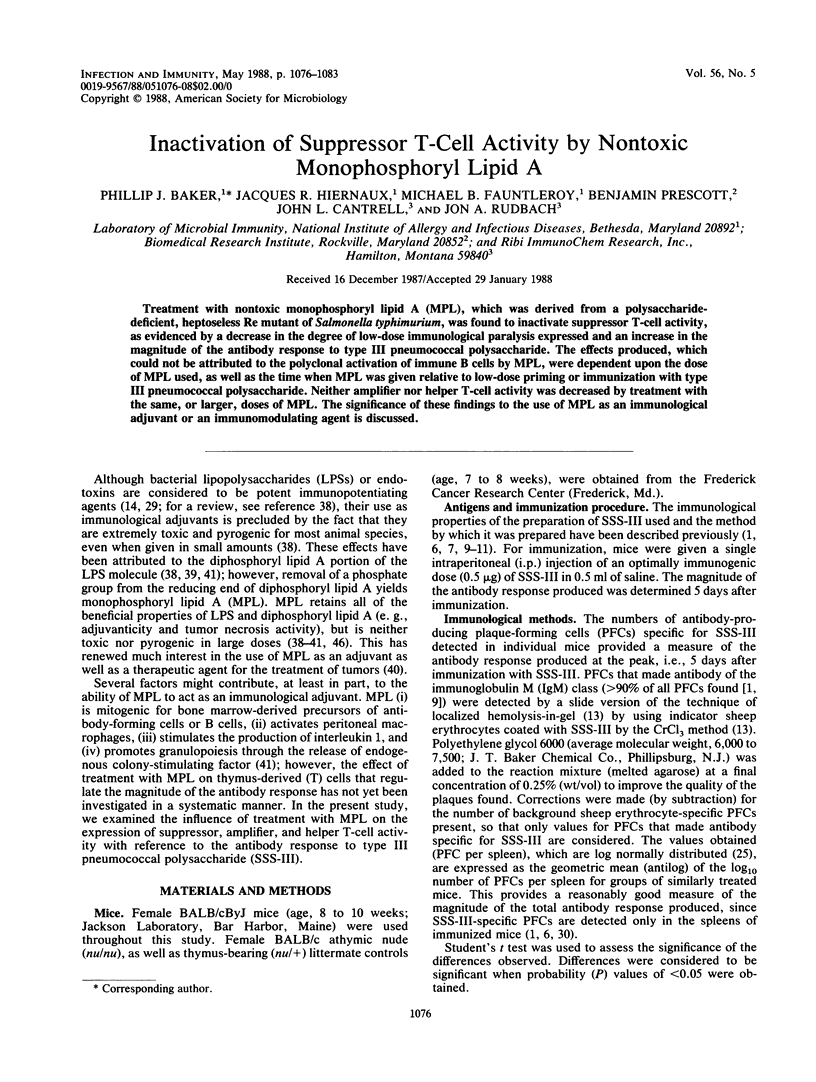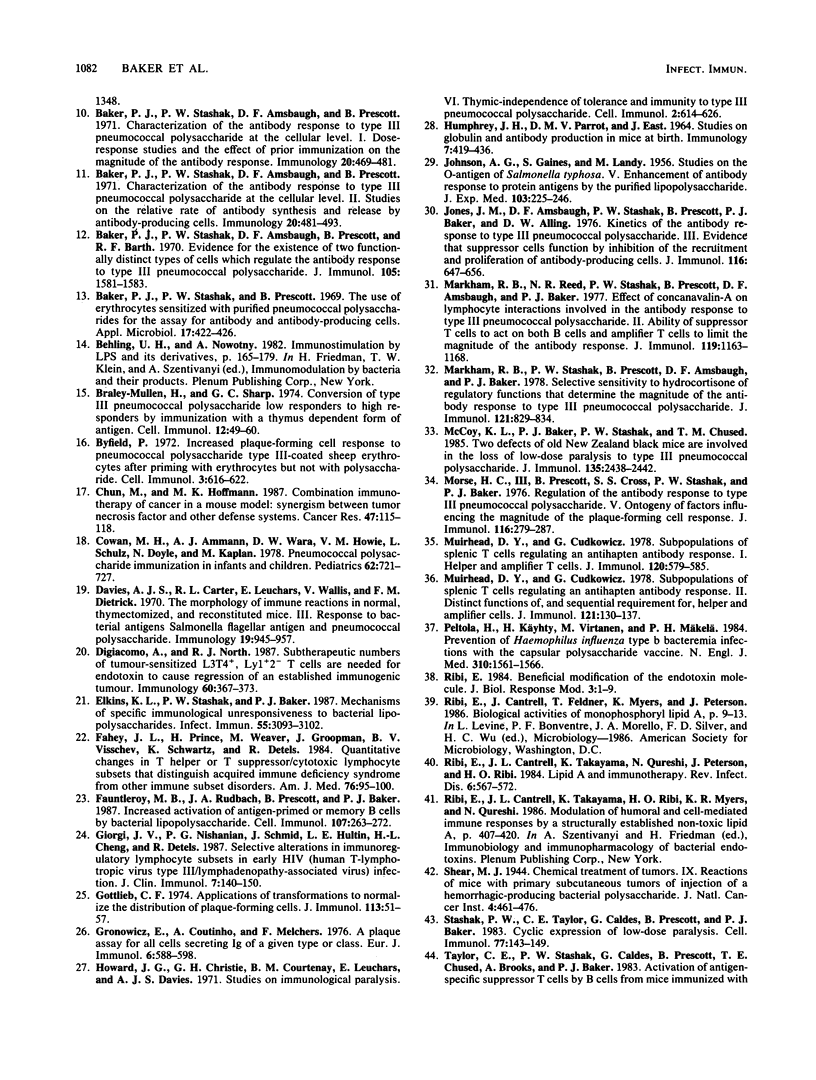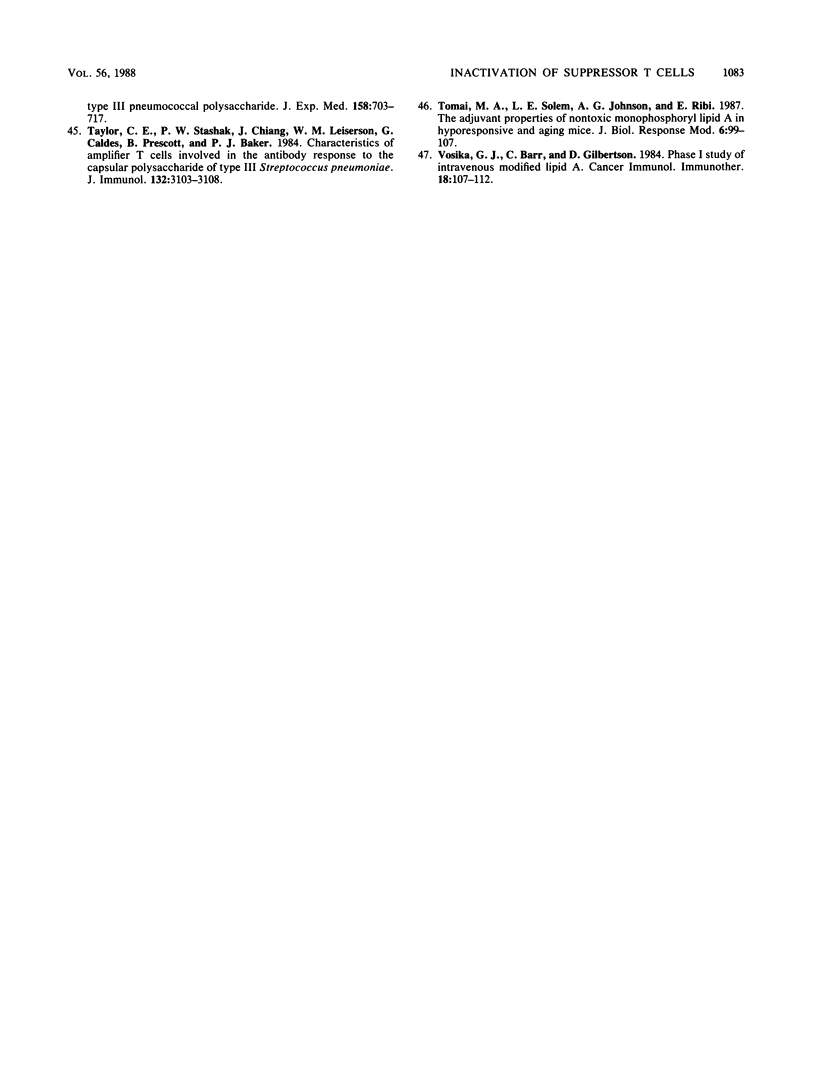Abstract
Treatment with nontoxic monophosphoryl lipid A (MPL), which was derived from a polysaccharide-deficient, heptoseless Re mutant of Salmonella typhimurium, was found to inactivate suppressor T-cell activity, as evidenced by a decrease in the degree of low-dose immunological paralysis expressed and an increase in the magnitude of the antibody response to type III pneumococcal polysaccharide. The effects produced, which could not be attributed to the polyclonal activation of immune B cells by MPL, were dependent upon the dose of MPL used, as well as the time when MPL was given relative to low-dose priming or immunization with type III pneumococcal polysaccharide. Neither amplifier nor helper T-cell activity was decreased by treatment with the same, or larger, doses of MPL. The significance of these findings to the use of MPL as an immunological adjuvant or an immunomodulating agent is discussed.
Full text
PDF







Selected References
These references are in PubMed. This may not be the complete list of references from this article.
- Baker P. H., Stashak P. W. Quantitative and qualitative studies on the primary antibody response to pneumococcal polysaccharides at ehe cellular level. J Immunol. 1969 Dec;103(6):1342–1348. [PubMed] [Google Scholar]
- Baker P. J., Amsbaugh D. F., Stashak P. W., Caldes G., Prescott B. Direct evidence for the involvement of T suppressor cells in the expression of low-dose paralysis to type III pneumococcal polysaccharide. J Immunol. 1982 Mar;128(3):1059–1062. [PubMed] [Google Scholar]
- Baker P. J., Amsbaugh D. F., Stashak P. W., Caldes G., Prescott B. Regulation of the antibody response to pneumococcal polysaccharide by thymus-derived cells. Rev Infect Dis. 1981 Mar-Apr;3(2):332–341. doi: 10.1093/clinids/3.2.332. [DOI] [PubMed] [Google Scholar]
- Baker P. J., Barth R. F., Stashak P. W., Amsbaugh D. F. Enhancement of the antibody response to type 3 pneumococcal polysaccharide in mice treated with antilymphocyte serum. J Immunol. 1970 May;104(5):1313–1315. [PubMed] [Google Scholar]
- Baker P. J., Fauntleroy M. B., Stashak P. W., McCoy K. L., Chused T. M. Increased amplifier T cell activity in autoimmune NZB mice and its possible significance in the expression of autoimmune disease. Immunobiology. 1986 Jul;171(4-5):400–411. doi: 10.1016/S0171-2985(86)80072-9. [DOI] [PubMed] [Google Scholar]
- Baker P. J., Hiernaux J. R., Stashak P. W., Rudbach J. A. Cyclic development of immunological memory to bacterial lipopolysaccharide. Infect Immun. 1985 Apr;48(1):1–6. doi: 10.1128/iai.48.1.1-6.1985. [DOI] [PMC free article] [PubMed] [Google Scholar]
- Baker P. J., Prescott B., Stashak P. W., Amsbaugh D. F. Characterization of the antibody response to type 3 pneumococcal polysaccharide at the cellular level. 3. Studies on the average avidity of the antibody produced by specific plaque-forming cells. J Immunol. 1971 Sep;107(3):719–724. [PubMed] [Google Scholar]
- Baker P. J., Reed N. D., Stashak P. W., Amsbaugh D. F., Prescott B. Regulation of the antibody response to type 3 pneumococcal polysaccharide. I. Nature of regulatory cells. J Exp Med. 1973 Jun 1;137(6):1431–1441. doi: 10.1084/jem.137.6.1431. [DOI] [PMC free article] [PubMed] [Google Scholar]
- Baker P. J., Stashak P. W., Amsbaugh D. F., Prescott B., Barth R. F. Evidence for the existence of two functionally distinct types of cells which regulate the antibody response to type 3 pneumococcal polysaccharide. J Immunol. 1970 Dec;105(6):1581–1583. [PubMed] [Google Scholar]
- Baker P. J., Stashak P. W., Amsbaugh D. F., Prescott B. Characterization of the antibody response to type 3 pneumococcal polysaccharide at the cellular level. I. Dose-response studies and the effect of prior immunization on the magnitude of the antibody response. Immunology. 1971 Apr;20(4):469–480. [PMC free article] [PubMed] [Google Scholar]
- Baker P. J., Stashak P. W., Prescott B. Use of erythrocytes sensitized with purified pneumococcal polysaccharides for the assay of antibody and antibody-producing cells. Appl Microbiol. 1969 Mar;17(3):422–426. doi: 10.1128/am.17.3.422-426.1969. [DOI] [PMC free article] [PubMed] [Google Scholar]
- Braley-Mullen H., Sharp G. C. Conversion of type III pneumococcal polysaccharide low responders to high responders by immunization with a thymus-dependent form of antigen. Cell Immunol. 1974 Apr;12(1):49–60. doi: 10.1016/0008-8749(74)90055-0. [DOI] [PubMed] [Google Scholar]
- Byfield P. Increased plaque-forming cell response to pneumococcal polysaccharide type 3-coated sheep erythrocytes after priming with erythrocytes but not with polysaccharide. Cell Immunol. 1972 Apr;3(4):616–622. doi: 10.1016/0008-8749(72)90123-2. [DOI] [PubMed] [Google Scholar]
- Chun M., Hoffmann M. K. Combination immunotherapy of cancer in a mouse model: synergism between tumor necrosis factor and other defense systems. Cancer Res. 1987 Jan 1;47(1):115–118. [PubMed] [Google Scholar]
- Cowan M. J., Ammann A. J., Wara D. W., Howie V. M., Schultz L., Doyle N., Kaplan M. Pneumococcal polysaccharide immunization in infants and children. Pediatrics. 1978 Nov;62(5):721–727. [PubMed] [Google Scholar]
- Davies A. J., Carter R. L., Leuchars E., Wallis V., Dietrich F. M. The morphology of immune reactions in normal, thymectomized and reconstituted mice. 3. Response to bacterial antigens: salmonellar flagellar antigen and pneumococcal plysaccharide. Immunology. 1970 Dec;19(6):945–957. [PMC free article] [PubMed] [Google Scholar]
- Digiacomo A., North R. J. Subtherapeutic numbers of tumour-sensitized, L3T4+, Ly 1+2- T cells are needed for endotoxin to cause regression of an established immunogenic tumour. Immunology. 1987 Mar;60(3):367–373. [PMC free article] [PubMed] [Google Scholar]
- Elkins K. L., Stashak P. W., Baker P. J. Mechanisms of specific immunological unresponsiveness to bacterial lipopolysaccharides. Infect Immun. 1987 Dec;55(12):3093–3102. doi: 10.1128/iai.55.12.3093-3102.1987. [DOI] [PMC free article] [PubMed] [Google Scholar]
- Fahey J. L., Prince H., Weaver M., Groopman J., Visscher B., Schwartz K., Detels R. Quantitative changes in T helper or T suppressor/cytotoxic lymphocyte subsets that distinguish acquired immune deficiency syndrome from other immune subset disorders. Am J Med. 1984 Jan;76(1):95–100. doi: 10.1016/0002-9343(84)90756-3. [DOI] [PubMed] [Google Scholar]
- Fauntleroy M. B., Rudbach J. A., Prescott B., Baker P. J. Increased activation of antigen-primed or memory B cells by bacterial lipopolysaccharide. Cell Immunol. 1987 Jul;107(2):263–272. doi: 10.1016/0008-8749(87)90235-8. [DOI] [PubMed] [Google Scholar]
- Giorgi J. V., Nishanian P. G., Schmid I., Hultin L. E., Cheng H. L., Detels R. Selective alterations in immunoregulatory lymphocyte subsets in early HIV (human T-lymphotropic virus type III/lymphadenopathy-associated virus) infection. J Clin Immunol. 1987 Mar;7(2):140–150. doi: 10.1007/BF00916008. [DOI] [PubMed] [Google Scholar]
- Gottlieb C. F. Application of transformations to normalize the distribution of plaque-forming cells. J Immunol. 1974 Jul;113(1):51–57. [PubMed] [Google Scholar]
- Gronowicz E., Coutinho A., Melchers F. A plaque assay for all cells secreting Ig of a given type or class. Eur J Immunol. 1976 Aug;6(8):588–590. doi: 10.1002/eji.1830060812. [DOI] [PubMed] [Google Scholar]
- HUMPHREY J. H., PARROTT D. M., EAST J. STUDIES ON GLOBULIN AND ANTIBODY PRODUCTION IN MICE THYMECTOMIZED AT BIRTH. Immunology. 1964 Jul;7:419–439. [PMC free article] [PubMed] [Google Scholar]
- Howard J. G., Christie G. H., Courtenay B. M., Leuchars E., Davies A. J. Studies on immunological paralysis. VI. Thymic-independence of tolerance and immunity to type 3 pneumococcal polysaccharide. Cell Immunol. 1971 Dec;2(6):614–626. doi: 10.1016/0008-8749(71)90009-8. [DOI] [PubMed] [Google Scholar]
- JOHNSON A. G., GAINES S., LANDY M. Studies on the O antigen of Salmonella typhosa. V. Enhancement of antibody response to protein antigens by the purified lipopolysaccharide. J Exp Med. 1956 Feb 1;103(2):225–246. doi: 10.1084/jem.103.2.225. [DOI] [PMC free article] [PubMed] [Google Scholar]
- Jones J. M., Amsbaugh D. F., Stashak P. W., Prescott B., Baker P. J., Alling D. W. Kinetics of the antibody response to type III pneumococcal polysaccharide. I. Evidence that suppressor cells function by inhibiting the recruitment and proliferation of antibody-producing cells. J Immunol. 1976 Mar;116(3):647–656. [PubMed] [Google Scholar]
- Markham R. B., Reed N. D., Stashak P. W., Prescott B., Amsbaugh D. F., Baker P. J. Effect of concanavalin A on lymphocyte interactions involved in the antibody response to type III pneumococcal polysaccharide. II. Ability of suppressor T cells to act on both B cells and amplified T cells to limit the magnitude of the antibody response. J Immunol. 1977 Sep;119(3):1163–1168. [PubMed] [Google Scholar]
- Markham R. B., Stashak P. W., Prescott B., Amsbaugh D. F., Baker P. J. Selective sensitivity to hydrocortisone of regulatory functions that determine the magnitude of the antibody response to type III pneumococcal polysaccharide. J Immunol. 1978 Sep;121(3):829–834. [PubMed] [Google Scholar]
- McCoy K. L., Baker P. J., Stashak P. W., Chused T. M. Two defects in old New Zealand Black mice are involved in the loss of low-dose paralysis to type III pneumococcal polysaccharide. J Immunol. 1985 Oct;135(4):2438–2442. [PubMed] [Google Scholar]
- Morse H. C., 3rd, Prescott B., Cross S. S., Stashak P. W., Baker P. J. Regulation of the antibody response to type III pneumococcal polysaccharide. V. Ontogeny of factors influencing the magnitude of the plaque-forming cell response. J Immunol. 1976 Feb;116(2):279–287. [PubMed] [Google Scholar]
- Muirhead D. Y., Cudkowicz G. Subpopulations of splenic T cells regulating an anti-hapten antibody response. II. Distinct functions of, and sequential requirement for, helper and amplifier cells. J Immunol. 1978 Jul;121(1):130–137. [PubMed] [Google Scholar]
- Muirhead D. Y., Cudkowicz G. Subpopulations of splenic T cells regulating an antihapten antibody response. I. Helper and amplifier cells. J Immunol. 1978 Feb;120(2):579–585. [PubMed] [Google Scholar]
- Peltola H., Käyhty H., Virtanen M., Mäkelä P. H. Prevention of Hemophilus influenzae type b bacteremic infections with the capsular polysaccharide vaccine. N Engl J Med. 1984 Jun 14;310(24):1561–1566. doi: 10.1056/NEJM198406143102404. [DOI] [PubMed] [Google Scholar]
- Ribi E. Beneficial modification of the endotoxin molecule. J Biol Response Mod. 1984;3(1):1–9. [PubMed] [Google Scholar]
- Ribi E., Cantrell J. L., Takayama K., Qureshi N., Peterson J., Ribi H. O. Lipid A and immunotherapy. Rev Infect Dis. 1984 Jul-Aug;6(4):567–572. doi: 10.1093/clinids/6.4.567. [DOI] [PubMed] [Google Scholar]
- Stashak P. W., Taylor C. E., Caldes G., Prescott B., Baker P. J. Cyclic expression of low-dose paralysis. Cell Immunol. 1983 Apr 1;77(1):143–149. doi: 10.1016/0008-8749(83)90014-x. [DOI] [PubMed] [Google Scholar]
- Taylor C. E., Stashak P. W., Chiang J., Leiserson W. M., Caldes G., Prescott B., Baker P. J. Characteristics of amplifier T cells involved in the antibody response to the capsular polysaccharide of type III Streptococcus pneumoniae. J Immunol. 1984 Jun;132(6):3103–3108. [PubMed] [Google Scholar]
- Vosika G. J., Barr C., Gilbertson D. Phase-I study of intravenous modified lipid A. Cancer Immunol Immunother. 1984;18(2):107–112. doi: 10.1007/BF00205743. [DOI] [PMC free article] [PubMed] [Google Scholar]


